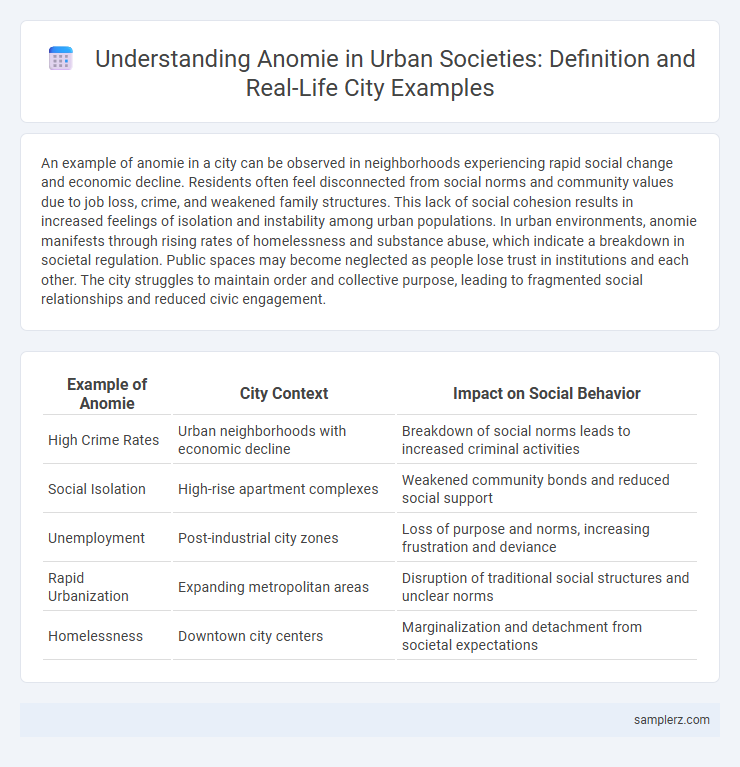An example of anomie in a city can be observed in neighborhoods experiencing rapid social change and economic decline. Residents often feel disconnected from social norms and community values due to job loss, crime, and weakened family structures. This lack of social cohesion results in increased feelings of isolation and instability among urban populations. In urban environments, anomie manifests through rising rates of homelessness and substance abuse, which indicate a breakdown in societal regulation. Public spaces may become neglected as people lose trust in institutions and each other. The city struggles to maintain order and collective purpose, leading to fragmented social relationships and reduced civic engagement.
Table of Comparison
| Example of Anomie | City Context | Impact on Social Behavior |
|---|---|---|
| High Crime Rates | Urban neighborhoods with economic decline | Breakdown of social norms leads to increased criminal activities |
| Social Isolation | High-rise apartment complexes | Weakened community bonds and reduced social support |
| Unemployment | Post-industrial city zones | Loss of purpose and norms, increasing frustration and deviance |
| Rapid Urbanization | Expanding metropolitan areas | Disruption of traditional social structures and unclear norms |
| Homelessness | Downtown city centers | Marginalization and detachment from societal expectations |
Rising Isolation: The Disconnected Urban Citizen
Rising isolation in urban environments exemplifies anomie, where city residents experience social fragmentation and weakened community ties. High population density paradoxically fosters disconnection, reducing trust and engagement among neighbors. This fragmentation intensifies feelings of alienation, contributing to increased mental health issues and diminishing social cohesion in metropolitan areas.
The Breakdown of Community Bonds in Metropolitan Areas
The breakdown of community bonds in metropolitan areas often manifests as social isolation and weakened neighborhood ties, contributing to widespread anomie. High population density combined with urban anonymity results in reduced social cohesion and trust among residents. This erosion of collective values increases vulnerability to crime and exacerbates mental health issues within the urban population.
Homelessness as an Urban Anomie Phenomenon
Homelessness in urban areas exemplifies anomie by reflecting social instability and breakdown in community norms, often resulting from economic disparities and inadequate social support systems. This phenomenon highlights disconnection between individuals and societal structures, leading to alienation and marginalization in city environments. The presence of homeless populations underscores the failure of urban institutions to integrate vulnerable groups effectively, exacerbating social fragmentation.
Social Alienation in High-Density Cities
High-density cities often experience social alienation as residents face anonymity and weakened community bonds, leading to increased feelings of isolation and detachment. The rapid urbanization and overcrowding contribute to a breakdown in social norms, resulting in anomie characterized by a lack of belonging and social integration. Studies highlight that limited social interactions and fragmented neighborhoods in metropolitan areas exacerbate the sense of alienation among urban dwellers.
Anomie Reflected in Urban Crime Rates
Urban areas experiencing rapid social change often exhibit high anomie levels, correlating with increased crime rates. Disrupted social norms and weakened community bonds contribute to theft, vandalism, and violence. Studies indicate neighborhoods with low social cohesion face significantly higher instances of criminal behavior.
Youth Disengagement and Vandalism in City Spaces
Youth disengagement in urban areas often leads to increased tendencies toward vandalism in city spaces, reflecting a broader state of anomie characterized by social norms breakdown and weakened community bonds. Studies reveal that neighborhoods with limited access to recreational and educational resources experience higher rates of youth alienation, resulting in destructive behaviors such as graffiti and property damage. Addressing these challenges requires targeted social programs designed to rebuild trust and foster a sense of belonging among marginalized urban youth.
The Erosion of Traditional Values Amidst Urbanization
Rapid urbanization in cities often leads to the erosion of traditional values as community bonds weaken and social norms become ambiguous. This breakdown in shared cultural standards can result in anomie, where individuals feel disconnected and struggle to find their place within society. The lack of cohesive social frameworks in metropolitan areas contributes to increased social isolation and a decline in communal responsibility.
Anonymity and Its Impact on Social Trust in Cities
Anonymity in urban environments often leads to reduced social trust, as individual interactions become impersonal and transient. This detachment fosters anomie, where citizens feel disconnected from communal norms and supportive social networks. Consequently, the lack of accountability and shared identity undermines community cohesion and increases social isolation in cities.
The Prevalence of Substance Abuse in Urban Centers
Substance abuse represents a significant example of anomie in urban centers, where social norms weaken under the pressures of rapid urbanization and socioeconomic disparities. High rates of addiction to alcohol, opioids, and illicit drugs reflect the breakdown of community bonds and lack of social regulation in cities like New York, Los Angeles, and Chicago. This epidemic exacerbates crime rates, public health crises, and homelessness, highlighting the profound impact of social disintegration on metropolitan populations.
Mental Health Struggles: Anomie’s Invisible Toll in Urban Life
Urban environments often foster social isolation, resulting in feelings of alienation and anonymity that contribute to mental health challenges such as depression and anxiety. The breakdown of community bonds in cities erodes social support systems, exacerbating stress and increasing the risk of suicide. Chronic exposure to urban anomie disrupts individual identity and belonging, intensifying psychological distress among city residents.

example of anomie in city Infographic
 samplerz.com
samplerz.com